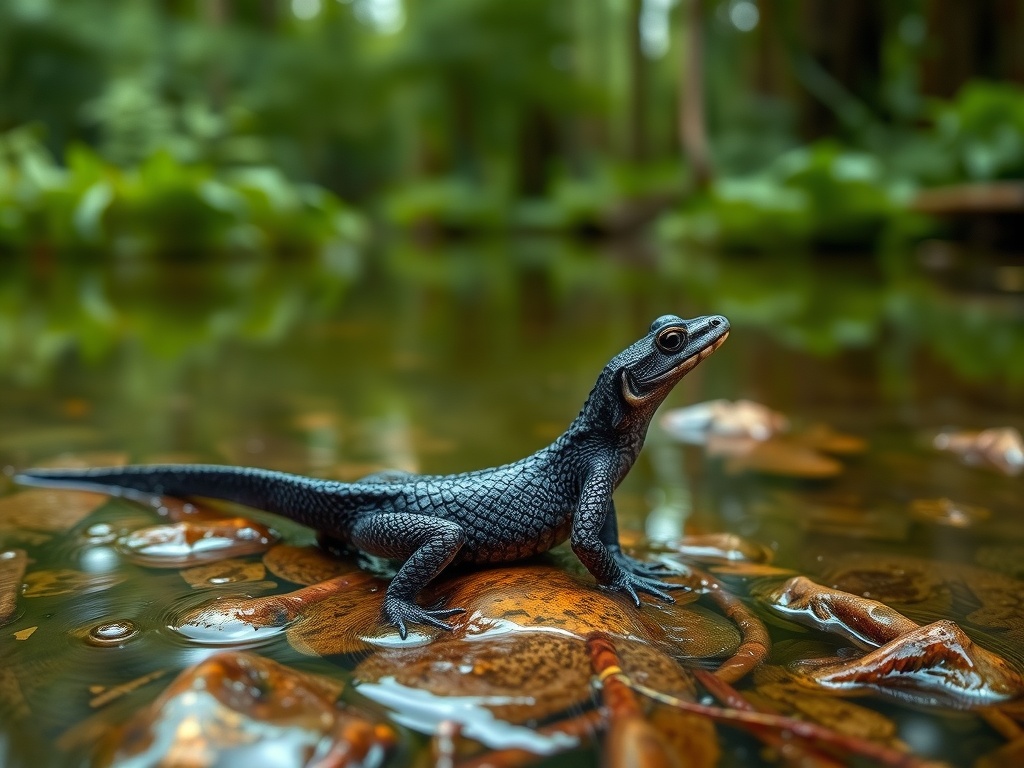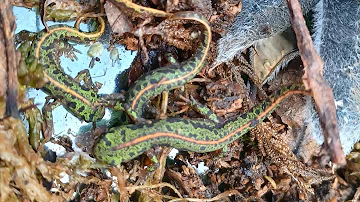
Italian Crested Newt
Triturus carnifex

Meet the Italian Crested Newt
The Italian Crested Newt is a large, semi-aquatic amphibian native primarily to Italy and parts of the Balkan Peninsula. Recognized by its robust body, dark marbled coloration, and the prominent jagged crest found on males during the breeding season, this species inhabits still or slow-moving freshwater bodies. It spends much of its life on land, seeking shelter in woodlands, meadows, or gardens, but returns to water each spring to breed. Italian Crested Newts are sensitive to environmental changes, making them important indicators of ecosystem health.
Classification
Amphibian
Habitat
Freshwater ponds, lakes, and slow-moving streams surrounded by forests or grasslands
Diet
Carnivore
Lifespan
10-15 years
Conservation
Near Threatened
Weight
7-20 grams
📖Fascinating Facts
Striking Breeding Crest
During the breeding season, males develop a spectacular, jagged crest that runs from their head to the tip of their tail, which is used to attract females.
Seasonal Aquatic Life
Italian Crested Newts are primarily terrestrial outside the breeding season, but migrate to water bodies in spring to mate and lay eggs.
Regenerative Abilities
Like many salamanders, they can regenerate lost limbs and tails, a remarkable adaptation that aids survival.
📋Detailed Description
The Italian crested newt (Triturus carnifex) is a robust, medium-to-large newt species, with adults typically reaching 12–16 cm in length, although some individuals may grow up to 18 cm. The dorsal coloration is generally dark brown to black, often mottled with lighter spots, while the ventral side is bright yellow or orange with irregular black blotches. Males are distinguished during the breeding season by a striking, jagged dorsal crest that runs from the head to the tail, reaching up to 1.5 cm in height, and a silvery-white stripe along the tail. Females lack the pronounced crest and are generally larger-bodied. The skin texture varies seasonally, becoming smoother and more glandular in aquatic phases, aiding in cutaneous respiration. The species has well-developed limbs and a laterally compressed tail, facilitating both terrestrial locomotion and efficient swimming. Italian crested newts possess a keen sense of smell and vision, which are crucial for foraging and mate detection. Their lifespan in the wild is estimated at 10–14 years, with some captive individuals living longer. The species is primarily nocturnal and exhibits strong site fidelity, often returning to the same breeding ponds annually.
💡 Did you know?
Italian Crested Newts can hybridize with closely related newt species, producing offspring with a blend of characteristics.
🔬Research & Sources
Wikipedia Summary
The Italian crested newt is a species of newt in the family Salamandridae.
Last Modified: 12/7/2024
🎭Behavior & Social Structure
Italian crested newts are largely solitary outside the breeding season, spending daylight hours concealed under logs, stones, or dense vegetation to avoid desiccation and predation. They are crepuscular to nocturnal, emerging at dusk to forage. Their diet consists mainly of aquatic and terrestrial invertebrates, such as insects, worms, mollusks, and crustaceans; larger individuals may also consume tadpoles and small amphibians. In water, they employ a sit-and-wait hunting strategy, using rapid tongue projection or sudden lunges to capture prey. During the terrestrial phase, they actively search for food, relying on olfactory cues. Social interactions are limited outside the breeding season, but during courtship, males display elaborate behaviors including tail-fanning and undulating movements to attract females. Territorial disputes among males are resolved through visual displays and occasional physical combat.
👶Reproduction & Life Cycle
Breeding occurs from February to May, triggered by rising temperatures and increased rainfall. Males arrive at breeding sites first and establish territories in shallow, vegetated waters. Courtship involves complex displays: the male approaches the female, fans his tail to waft pheromones, and performs a series of undulating body movements. If receptive, the female follows the male, who deposits a spermatophore on the substrate, which the female then picks up with her cloaca. Females lay 200–400 eggs singly, attaching them to submerged plant leaves. Embryonic development lasts 2–4 weeks, depending on water temperature. Larvae are aquatic, with external gills and a finned tail, and undergo metamorphosis after 2–3 months. There is no parental care post-oviposition. Sexual maturity is typically reached at 3–4 years of age.
🛡️Adaptations & Survival
Triturus carnifex exhibits several adaptations for its semi-aquatic lifestyle. The seasonal development of a high dorsal crest in males enhances visual signaling during courtship. The skin is highly permeable, facilitating cutaneous respiration, especially in oxygen-poor aquatic environments. Glandular skin secretes toxins (mainly tetrodotoxin-like compounds) that deter predators. The laterally compressed tail and webbed toes improve swimming efficiency. During terrestrial phases, the newts reduce metabolic rates and seek moist microhabitats to prevent dehydration. Their ability to detect chemical cues in water aids in locating breeding sites and conspecifics. The species demonstrates strong homing ability, returning to natal ponds even after displacement.
📚Research Sources
🎨Cultural Significance
While not widely featured in folklore, the Italian crested newt has local significance as an indicator of healthy aquatic ecosystems and is sometimes referenced in regional conservation campaigns. In some Italian rural traditions, newts were believed to be omens of rain or associated with water spirits. The species is occasionally kept in captivity for educational and research purposes, but there is no evidence of widespread traditional use.
🔬Recent Research & Discoveries
Recent genetic studies have clarified the phylogenetic relationships within the Triturus genus, revealing historical hybridization events and cryptic diversity. Ongoing research focuses on the effects of habitat fragmentation on gene flow and population viability. Studies on skin secretions have identified bioactive compounds with potential pharmacological applications. Conservation genetics projects are underway to monitor population structure and inform management strategies. Long-term monitoring programs in Italy and the Balkans are tracking population trends and the effectiveness of habitat restoration efforts.
🎥Wildlife Videos

Great Crested Newt Documentary
Documentary on the great crested newt and the work of Wildwood Trustee & Director of the Durrell Institute of Conservation ...
Wildwood Trust

2022 Crested Newt Efts
Some of the juveniles newts produced at our facility.
UK Crested Newts

Italian Crested Newt Courtship
Italian Crested Newt (Triturus carnifex) Fuscaldo locality, courtship display.
UK Crested Newts

Wild Italy - From The Alps to Tuscany | Full Italy Wildlife Documentary
From the snow-covered Dolomites to the turquoise blue of the Mediterranean, the spectacular landscape of Italy is already a ...
Get.factual

Wild Italy - From Sardinia to Abruzzo | Full Italy Wildlife Documentary
Sardinia is THE Mediterranean dream island for many people: clichés like crystal-clear water and picturesque coastlines are a ...
Get.factual

Italian Crested Newt Courting a Flavistic Female
Italian crested newt (Triturus carnifex) courtship (flavistic female).
UK Crested Newts
🌍Habitat Information
The Italian Crested Newt typically inhabits Freshwater ponds, lakes, and slow-moving streams surrounded by forests or grasslands environments. Italian Crested Newts have adapted to their environments with specialized features and behaviors.
Primary Habitat:
Freshwater ponds, lakes, and slow-moving streams surrounded by forests or grasslands
More detailed habitat information will be available soon.
🛡️Conservation Status
The Italian Crested Newt is currently classified as Near Threatened. Conservation efforts are crucial for preserving this species for future generations.
Common Threats:
- 🏠Habitat loss and fragmentation
- 🌡️Climate change impacts
- 🎯Hunting and poaching
- 🏭Human-wildlife conflict
⚠️Threats & Conservation Challenges
The Italian crested newt faces significant threats from habitat loss and fragmentation, primarily due to agricultural expansion, urbanization, and drainage of wetlands. Pollution from pesticides and fertilizers degrades breeding sites, while introduced fish and crayfish prey on eggs and larvae. Road mortality during seasonal migrations and climate change-induced alterations in precipitation patterns further threaten populations. Hybridization with related newt species, such as Triturus cristatus, can lead to genetic introgression. The species is listed as 'Vulnerable' by the IUCN, with declining population trends observed across much of its range. Conservation efforts focus on habitat restoration, creation of new breeding ponds, and legal protection of key sites.
🔬Scientific Classification
Scientific Name
Triturus carnifex
Classification Hierarchy
🔍 About Taxonomic Classification
Taxonomic classification is a hierarchical system used by scientists to classify and organize living organisms based on shared characteristics and evolutionary relationships.
The system moves from broad categories (Kingdom) to increasingly specific ones, with each animal's scientific name typically consisting of its Genus and species.
📝Community Notes
Share your observations and insights about the Italian Crested Newt with our community of wildlife enthusiasts.
Join Our Community
Sign in to share your observations and connect with fellow wildlife enthusiasts.
Sign In to ContributeNo community notes yet
Be the first to share your observations about the Italian Crested Newt!
Explore Italian Crested Newt
Select a tab above to learn more about this amazing animal.
📸Photo Gallery
No photos available for this animal yet.
🌟Discover More Wildlife
Continue your journey of discovery with more fascinating animals from our database
